
Puzzle video games make up a broad genre of video games that emphasize puzzle solving. The types of puzzles can test problem-solving skills, including logic, pattern recognition, sequence solving, spatial recognition, and word completion. Many puzzle games involve a real-time element and require quick thinking, such as Tetris (1985) and Lemmings (1991).

Tetris Attack, also known as Panel de Pon in Japan, is a puzzle video game developed by Intelligent Systems and published by Nintendo for the Super Nintendo Entertainment System. A Game Boy version was released a year later. In the game, the player must arrange matching colored blocks in vertical or horizontal rows to clear them. The blocks steadily rise towards the top of the playfield, with new blocks being added at the bottom. Several gameplay modes are present, including a time attack and multiplayer mode.
The Learning Company (TLC) was an educational software company founded in 1980 in Palo Alto, California and headquartered in Fremont, California. The company produced a grade-based line of learning software, edutainment games, and productivity tools. Its titles included the flagship series Reader Rabbit, for preschoolers through second graders, and The ClueFinders, for more advanced students. The company was also known for publishing licensed educational titles featuring characters such as Arthur, Scooby-Doo, Zoboomafoo, and Caillou.

Broderbund Software, Inc. was an American maker of video games, educational software, and productivity tools. Broderbund is best known for the 8-bit video game hits Choplifter, Lode Runner, Karateka, and Prince of Persia, as well as The Print Shop—originally for printing signs and banners on dot matrix printers—and the Myst and Carmen Sandiego games. The company was founded in Eugene, Oregon, and moved to San Rafael, California, then later to Novato, California. Brøderbund was purchased by SoftKey in 1998.
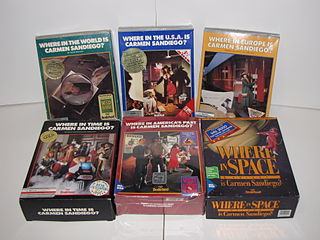
Carmen Sandiego is a series of American educational mystery video games that spawned an edutainment franchise of the same name. The game released in 1985, Where in the World Is Carmen Sandiego?, started off both the video game series and the franchise as a whole, which has continued up to the present day. Each game of the series has a particular theme and subject, where the player must use their knowledge to find Carmen Sandiego or any of her innumerable henchmen. This series was originally owned by Broderbund, but is now owned by Houghton Mifflin Harcourt. Since its initial release the series has won over 125 awards and accolades.

Mario Party is a party video game series featuring characters from the Mario franchise in which up to four local players or computer-controlled characters compete in a board game interspersed with minigames. The games are currently developed by NDcube and published by Nintendo, being previously developed by Hudson Soft. The series is known for its party game elements, including the often unpredictable multiplayer modes that allow play with up to four, and sometimes eight, human players or CPUs.
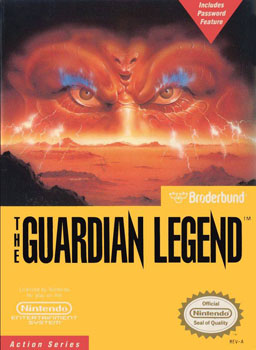
The Guardian Legend is a 1988 hybrid action-adventure/shoot 'em up video game developed by Compile for the Nintendo Entertainment System (NES). It is the sequel to the 1986 MSX game Guardic, and was published and released in Japan by Irem in 1988, in North America by Broderbund in 1989, and in Europe by Nintendo in 1990.

Voyage: Inspired by Jules Verne is a point-and-click adventure game with pre-rendered graphics, developed by Kheops Studio and published by The Adventure Company for the PC in 2005. The game's story focuses on a French adventurer's journey to the Moon in the 19th century, and the ancient lunar civilization he subsequently finds.

Super Solvers: Gizmos & Gadgets is an educational science video game designed by The Learning Company. It is intended to teach children between the ages of 7 and 12 introductory mechanics, namely simple machines, magnets, basic electronics, and forms of energy. The original game is compatible with computers running DOS 3.3 or higher and a later CD release added Windows 95 and Macintosh compatibility. A popular game through 1997, The Learning Company, then incorporated with Broderbund, discontinued Gizmos & Gadgets in 1998. Riverdeep eventually obtained the rights and re-released it in some of the "Adventure Workshop" collections.

Carmen Sandiego is a media franchise based on a series of computer video games created by the American software company Broderbund. While the original 1985 Where in the World Is Carmen Sandiego? video game was classified as a "mystery exploration" series by creators and the media, the series would later be deemed edutainment when the games became unexpectedly popular in classrooms. The franchise centers around the fictional thieving villain of the same name, who is the ringleader of the criminal organization V.I.L.E.; the protagonists are agents of the ACME Detective Agency who try to thwart the crooks' plans to steal treasures from around the world, while the later ultimate goal is to capture Carmen Sandiego herself.

Logical Journey of the Zoombinis is an educational puzzle video game developed and published by Broderbund for the original and The Learning Company for the rerelease. It is the first game in the Zoombinis video game series.

Horse Isle is a browser-based massively multiplayer online role-playing game (MMORPG) first released in 2007. The game was developed and published independently by American duo Joe and Miranda Durbin. In May 2010, the second edition of the game, Horse Isle: Legend of the Esrohs was released, with gameplay and graphics differing significantly from the game's first release. This was followed by the released of Horse Isle 3: Infinite Wilds in August 2019, a downloadable three-dimensional edition of the game.
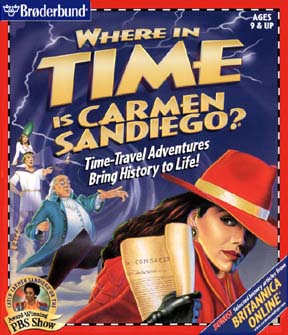
Carmen Sandiego's Great Chase Through Time is a 1997 edutainment point-and-click adventure game developed by Broderbund for Microsoft Windows and Macintosh devices. The game is a remake of the 1989 time-travel title Where in Time Is Carmen Sandiego?, making it the second Time video game in the Carmen Sandiego franchise. The game was strongly influenced by the short-lived PBS game show, Where in Time Is Carmen Sandiego?. The game was previewed at the 1997 Toy Fair in New York City. A demo version was included on the CD for Carmen Sandiego Word Detective and was available on the Carmen Sandiego website. After Broderbund was sold to The Learning Company, the game was re-released with the new title - Carmen Sandiego's Great Chase Through Time - but with minimal redesign.
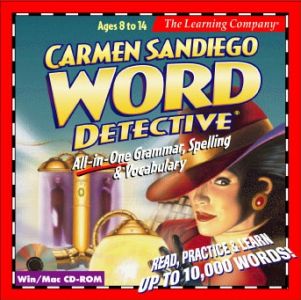
Carmen Sandiego Word Detective is a game in the Carmen Sandiego franchise which was released in 1997. The plot of the game sees Carmen Sandiego inventing a machine called the Babble-On Machine, and the player in the role of Agent 13, thwarting her plans by freeing all the other agents which have been captured by Carmen. The title is very similar in format to Carmen Sandiego Math Detective, which was released a year later.

Where in Space Is Carmen Sandiego? is an educational video game by Broderbund and Electronic Arts.
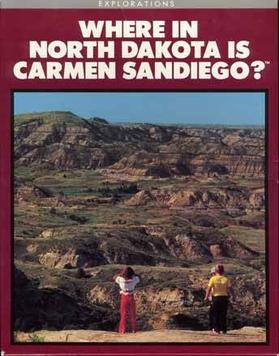
Where in North Dakota Is Carmen Sandiego? is a 1989 edutainment video game. It is the fourth game in the Carmen Sandiego video game series after World (1985), U.S.A. (1986), and Europe (1988). Having observed the popularity of the Carmen Sandiego franchise in the education of school children, educators were inspired to develop a North Dakota version to teach North Dakotans about their state's history and geography.

Thinkin' Things is a series of educational video games by the Edmark Corporation and released for Windows and Mac in the 1990s. Entries in the series include Thinkin' Things Collection 1 (Formerly Thinkin Things) (1993), Thinkin' Things Collection 2 (1994), Thinkin' Things Collection 3 (1995), the adventure game Thinkin' Things: Sky Island Mysteries (1998), Thinkin’ Things Galactic Brain Benders (1999), Thinkin' Things: All Around Frippletown (1999) and Thinkin' Things: Toony the Loon's Lagoon (1999).
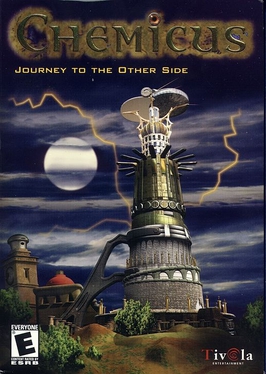
Chemicus: Journey to the Other Side is a 2001 educational adventure video game by Heureka-Klett as part of Tivola's "Quest for Knowledge" series. A sequel named Chemicus II: Die versunkene Stadt was released in 2002. The game was originally released in Germany.

The Mario's Early Years! series is a trilogy of point-and-click educational games released on MS-DOS and Super Nintendo Entertainment System by The Software Toolworks. The three games consist of Fun with Letters, Fun with Numbers and Preschool Fun.

A typing game is a genre of video games that involves correctly entering letters, words, or sentences on the keyboard. It began as a sub-genre of educational games designed to familiarize players with keyboard use and to improve skill at touch typing. Successfully typing a letter or word is tied to an action, such as firing a weapon at an attacking space ship. Companies associated with video games, like Broderbund, Atari, Inc., and Sirius Software all released typing games in the early 1980s. More formal educational software like Mavis Beacon Teaches Typing (1987) incorporates minigames as a practice option. Some later games, like Type Rush, add online competition based on players' typing speeds, making typing more addictive.



















